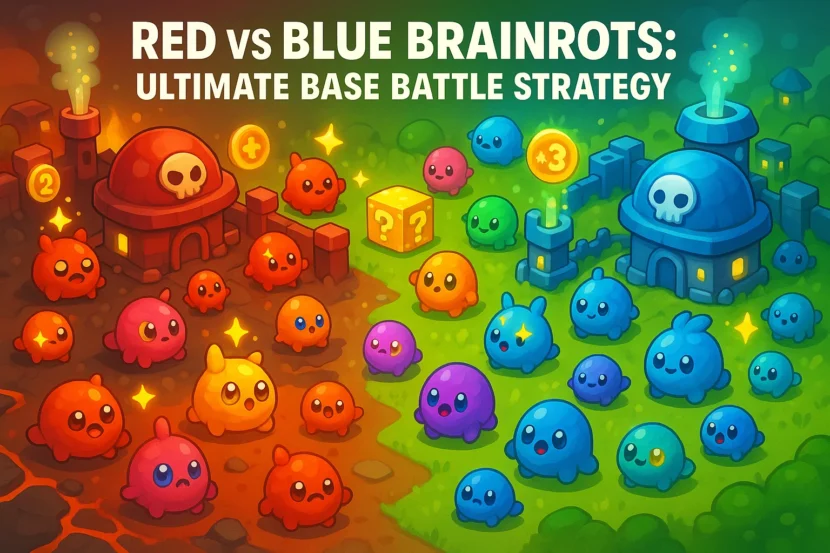In the latest challenge between Kefco and Unchain, the eternal rivalry of red vs blue brainrots takes center stage. Set in a competitive sandbox world where each player can only purchase and upgrade creatures of their designated color, the match becomes an intense test of economy management, luck, and strategy. This experiment not only entertains but also gives useful insight into the mechanics of collecting and upgrading brainrots efficiently—something that every player interested in how to buy brainrots or buy steal a brainrot brainrots can learn from.
Setting Up the Challenge
The rules were simple: each player could only collect brainrots that matched their team’s color—red for Unchain, blue for Kefco. Both started with basic units and a limited budget, racing against a 30-minute timer to build the most valuable base possible. What began as a friendly competition quickly evolved into a high-stakes battle as rare brainrots, lucky blocks, and god-tier mutations appeared on their respective carpets.
A major part of the challenge was the luck multiplier system. At first, it was set to x2, but as the game progressed, the hosts increased it to x4, x8, and finally infinite luck. This constantly shifting mechanic introduced new layers of unpredictability. The higher the multiplier, the rarer and more powerful the brainrots became—often making the difference between victory and defeat.
Red vs Blue: Key Observations
1. Early Game Advantage – The Blue Team
Kefco’s early luck brought him several diamond-tier and mythic brainrots, such as the Blueberry Octopus and Cappuccino Assassino. These generated consistent income per second and helped him scale quickly. In any game where progression depends on passive income, early upgrades like these are crucial.
2. Mid-Game Recovery – The Red Team
Unchain initially struggled with limited access to high-value red brainrots. However, when chance multipliers increased, the red side began to shine. Legendary creatures like Crimson Crostini and Brim Brim Patim provided huge earnings boosts, helping Unchain close the gap. For players planning to buy brainrots in their own runs, this shows how patience and timing your purchases can pay off when high-tier options appear.
3. Late Game Chaos – Infinite Luck Mode
When infinite luck activated, the field turned into total chaos. Both players began pulling god-tier and secret-class brainrots at unprecedented rates. Kefco’s blue side benefited from balanced stats, while Unchain’s red collection focused on massive output. However, high-tier brainrots also consumed more space, forcing both to sell off weaker units and optimize layouts for maximum profit. This is a key tip for anyone trying to optimize their base: constantly recycle low-tier units to make room for stronger ones.
Strategy Breakdown
For players looking to buy brainrots strategically, the video highlighted a few critical lessons:
- Color-Specific Efficiency: Focusing on your assigned color can seem limiting at first, but it forces specialization and smart decision-making.
- Upgrade Timing: Waiting for chance multipliers before making big purchases leads to better value overall.
- Space Management: Selling redundant or low-income brainrots is essential to avoid performance caps.
- High-Risk Rewards: Investing heavily in lucky blocks or god-tier spawns can either skyrocket your earnings or waste millions if luck turns against you.
When deciding to buy steal a brainrot brainrots, consider that the investment must balance risk, rarity, and long-term yield. A brainrot with high passive income may outperform a flashy mythic that only looks good on paper.
The Outcome
In the final minutes, both players surpassed the billion-dollar mark, constantly overtaking each other in real-time. Despite a tight race, the red team managed to pull slightly ahead thanks to several secret-tier pulls in the final seconds. Yet, both sides showcased that strategy and adaptability matter more than pure luck.
This red vs blue brainrot showdown proved that collecting efficiently is about more than random luck—it’s about timing, optimization, and adaptability. Whether you’re experimenting with your own color-specific challenge or just trying to decide when to buy brainrots, the lessons from this duel apply universally. Focus on maximizing efficiency, managing upgrades smartly, and taking calculated risks when the time is right.
